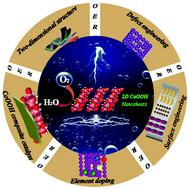当前位置:
X-MOL 学术
›
Chem. Commun.
›
论文详情
Our official English website, www.x-mol.net, welcomes your
feedback! (Note: you will need to create a separate account there.)
The latest development of CoOOH two-dimensional materials used as OER catalysts
Chemical Communications ( IF 4.3 ) Pub Date : 2020-11-06 , DOI: 10.1039/d0cc05876a Shengqi Zhang 1, 2, 3, 4, 5 , Tao Yu 1, 2, 3, 4, 5 , Hui Wen 1, 2, 3, 4, 5 , Zhiyuan Ni 1, 2, 3, 4 , Yan He 1, 2, 3, 4, 5 , Rui Guo 1, 2, 3, 4, 5 , Junhua You 1, 4, 6, 7 , Xuanwen Liu 1, 2, 3, 4, 5
Chemical Communications ( IF 4.3 ) Pub Date : 2020-11-06 , DOI: 10.1039/d0cc05876a Shengqi Zhang 1, 2, 3, 4, 5 , Tao Yu 1, 2, 3, 4, 5 , Hui Wen 1, 2, 3, 4, 5 , Zhiyuan Ni 1, 2, 3, 4 , Yan He 1, 2, 3, 4, 5 , Rui Guo 1, 2, 3, 4, 5 , Junhua You 1, 4, 6, 7 , Xuanwen Liu 1, 2, 3, 4, 5
Affiliation

|
Electrocatalytic water splitting, which is driven by renewable energy input to produce oxygen, has been widely regarded as a promising strategy in the future energy portfolio. The two-dimensional structure based on CoOOH nanosheets is easy to handle in the preparation process, low in cost, and has a small overpotential during water decomposition. Therefore, CoOOH two-dimensional materials have been widely used as electrocatalysts for the oxygen evolution reaction (OER). In this paper, we summarize the application of two-dimensional CoOOH nanosheets in the field of oxygen production from electrocatalytic water splitting. First, the different preparation methods of two-dimensional CoOOH nanosheets are briefly introduced. The structure–activity relationship of the two-dimensional CoOOH catalyst was analyzed from different viewpoints, such as doping, defects, etc. Finally, different catalytic mechanisms of CoOOH-based catalysts are discussed, and studies at the density functional theory (DFT) level are also provided to support the above mechanisms. To improve the readability of this review, a concise overview at the end of each section is given to illustrate some of the characteristics and trends of the studies in the corresponding part. The opportunities and challenges of two-dimensional CoOOH as an electrocatalyst in the future are summarized in the Conclusion section. This work will provide new insights and perspectives to the readers to understand the role of CoOOH nanosheets in the OER process.
中文翻译:

用作OER催化剂的CoOOH二维材料的最新进展
由可再生能源输入驱动产生氧气的电催化水分解已被广泛认为是未来能源组合中的一项有前途的策略。基于CoOOH纳米片的二维结构在制备过程中易于处理,成本低,并且在水分解过程中的过电位小。因此,CoOOH二维材料已被广泛用作氧释放反应(OER)的电催化剂。在本文中,我们总结了二维CoOOH纳米片在电催化水分解制氧领域中的应用。首先,简要介绍了二维CoOOH纳米片的不同制备方法。从不同的角度分析了二维CoOOH催化剂的结构-活性关系,例如掺杂,等最后,根据CoOOH的催化剂的不同的催化机制进行了讨论,并且还提供了在密度泛函理论(DFT)水平研究,以支持上述机制。为了提高本评论的可读性,每节末尾都给出了简要的概述,以说明相应部分研究的某些特征和趋势。结论部分概述了二维CoOOH作为未来电催化剂的机遇和挑战。这项工作将为读者提供新的见解和观点,以了解CoOOH纳米片在OER过程中的作用。
更新日期:2020-11-21
中文翻译:

用作OER催化剂的CoOOH二维材料的最新进展
由可再生能源输入驱动产生氧气的电催化水分解已被广泛认为是未来能源组合中的一项有前途的策略。基于CoOOH纳米片的二维结构在制备过程中易于处理,成本低,并且在水分解过程中的过电位小。因此,CoOOH二维材料已被广泛用作氧释放反应(OER)的电催化剂。在本文中,我们总结了二维CoOOH纳米片在电催化水分解制氧领域中的应用。首先,简要介绍了二维CoOOH纳米片的不同制备方法。从不同的角度分析了二维CoOOH催化剂的结构-活性关系,例如掺杂,等最后,根据CoOOH的催化剂的不同的催化机制进行了讨论,并且还提供了在密度泛函理论(DFT)水平研究,以支持上述机制。为了提高本评论的可读性,每节末尾都给出了简要的概述,以说明相应部分研究的某些特征和趋势。结论部分概述了二维CoOOH作为未来电催化剂的机遇和挑战。这项工作将为读者提供新的见解和观点,以了解CoOOH纳米片在OER过程中的作用。











































 京公网安备 11010802027423号
京公网安备 11010802027423号